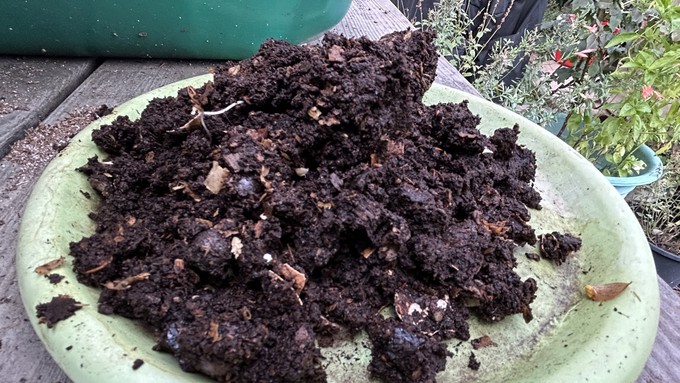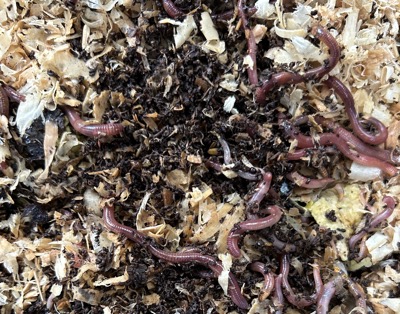
Two Placer County workshops focus on vermicomposting

This might look like a failed chocolate cake, but it's rich compost harvested from red wigglers. Kathy Morrison
I'm here today to ask you to invite some worms to Thanksgiving dinner.
Don't know any worms? OK, the timing's a little tight, but here's a tip: This weekend the Placer County master gardeners are going to have two sessions of worm meet-and-greet, as it were: Workshops in Roseville and Lincoln.
The Roseville one, from 10 a.m. to 11:30 a.m. Saturday, Nov. 18, at the Roseville Utility Exploration Center, costs $20 for Roseville residents and $22 for non-Roseville residents. Seating is limited, but when I looked this afternoon, there were still two spots available. Attendees get a starter family of red wiggler worms and a bin for them to live in. Check the city of Roseville's registration site here.
The afternoon workshop, at the Lincoln Library, 485 Twelve Bridges in Lincoln, is also Saturday, from 2 to 3 p.m. There is no fee and no registration required, but no wigglers or other materials will be provided. Attendees must acquire a brood of worms and a bin on their own. The workshop listing is here.
A worm home is not a complicated set-up: My bin is nothing more than a heavy-duty Husky bin, with holes drilled in the sides and the bottom. It sits on top of some bricks so any moisture can drip out. For bedding I use Eco Flake Animal Bedding -- shavings that are sold in bales for about $10 each at feed and some hardware stores. Leaves or shredded newspaper can be used as bedding as well. My previous bale lasted three years, so it's a worthwhile purchase.
The master gardeners will have plenty of advice on what and when to feed the worms, but I will add one tip: No cranberries.
My worms are going to be dining this Thanksgiving on apple cores, carrot trimmings, potato peelings and coffee grounds. (No meat, grease or citrus.) For dessert, they're going to get a pumpkin -- a whole one, left over from Halloween. That will last them until Christmas.

These little wigglers pay me back regularly with the richest compost you can imagine. I don't have a big space to harvest the entire bin, so I do micro-harvesting when I feed them. The plate in the photo above shows my typical haul, which gets spread on top of some soil in the garden, usually at a spot I think needs a boost, or in one of my potted plants.
If you can't attend either of the Placer workshops, you can still make friends with some worms in time for New Year's Eve, and certainly by Valentine's Day. The Sacramento County master gardeners' worm composting tips can be found on this page (roll down).
You and your plants will be glad you invited worms to dinner.
Comments
0 comments have been posted.Sacramento Digs Gardening to your inbox.
Food in My Back Yard Series
May 6: Maintain soil moisture with mulch for garden success
April 29: What's (already) wrong with my tomato plants?
April 22: Should you stock up on fertilizer? (Yes!)
April 15: Grow culinary herbs in containers
April 8: When to plant summer vegetables
April 1: Don't be fooled by these garden myths
March 25: Fertilizer tips: How to 'feed' your vegetables for healthy growth
March 18: Time to give vegetable seedlings some more space
March 11: Ways to win the fight against weeds
March 4: Potatoes from the garden
Feb. 25: Plant a fruit tree now -- for later
Feb. 18: How to squeeze more food into less space
Feb. 11: When to plant? Consider staggering your transplants
Feb. 4: Starting in seed starting
Sites We Like
Garden Checklist for week of May 11
Make the most of the lower temperatures early in the week. We’ll be back in the 80s by Thursday.
* Plant, plant, plant! It’s prime planting season in the Sacramento area. Time to set out those tomato transplants along with peppers and eggplants. Pinch off any flowers on new transplants to make them concentrate on establishing roots instead of setting premature fruit.
* Direct-seed melons, cucumbers, summer squash, corn, radishes, pumpkins and annual herbs such as basil.
* Harvest cabbage, lettuce, peas and green onions.
* In the flower garden, direct-seed sunflowers, cosmos, salvia, zinnias, marigolds, celosia and asters. (You also can transplant seedlings for many of the same flowers.)
* Plant dahlia tubers.
* Transplant petunias, marigolds and perennial flowers such as astilbe, columbine, coneflowers, coreopsis, dahlias, rudbeckia and verbena.
* Keep an eye out for slugs, snails, earwigs and aphids that want to dine on tender new growth.
* Feed summer bloomers with a balanced fertilizer.
* For continued bloom, cut off spent flowers on roses as well as other flowering plants.
* Add mulch to the garden to maintain moisture. Mulch also cuts down on weeds. But don’t let it mound around the stems or trunks of trees or shrubs. Leave about a 6-inch-to-1-foot circle to avoid crown rot or other problems.
* Remember to weed! Pull those nasties before they set seed.
* Water early in the day and keep seedlings evenly moist.